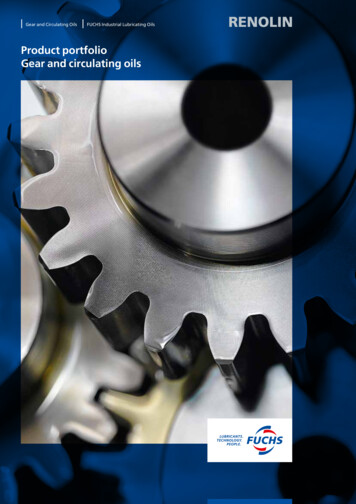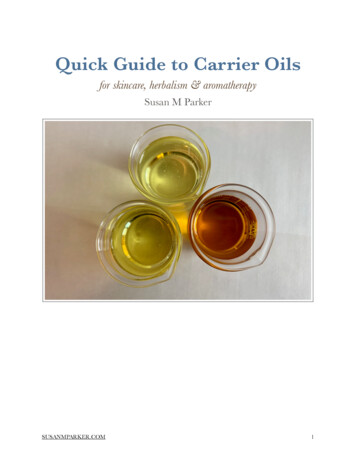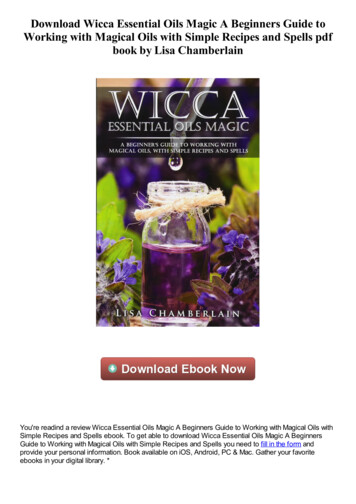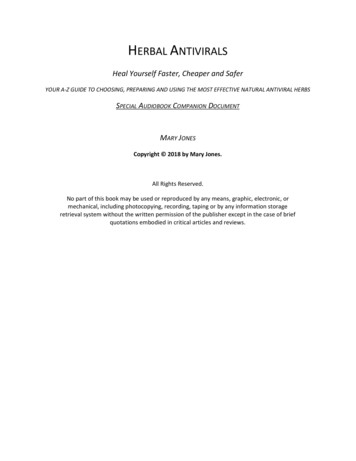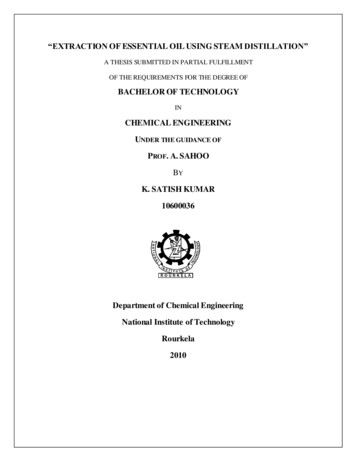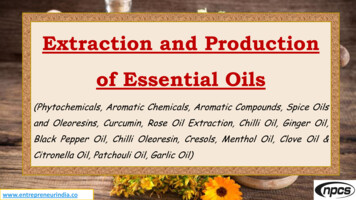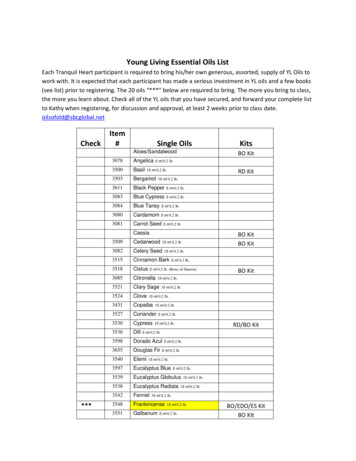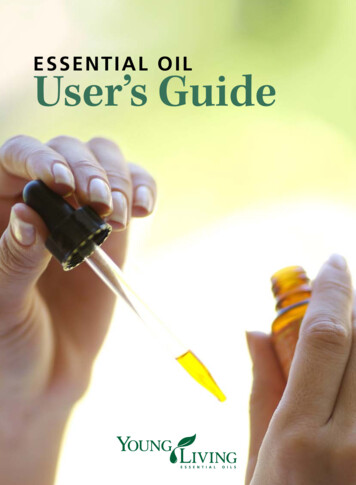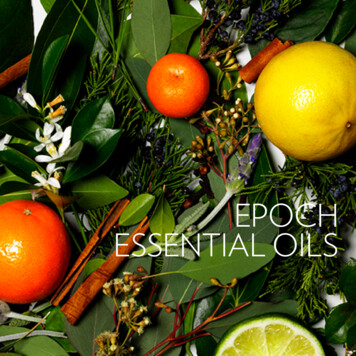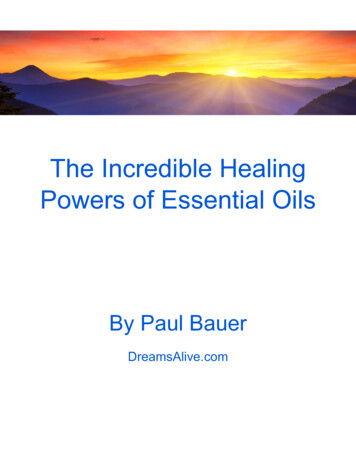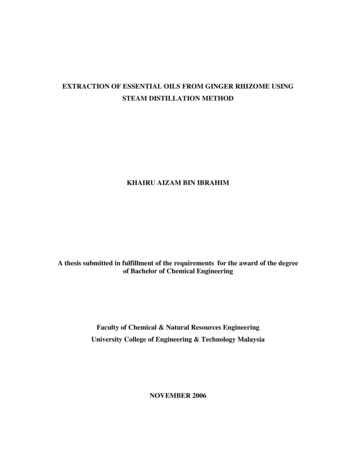
Transcription
EXTRACTION OF ESSENTIAL OILS FROM GINGER RHIZOME USINGSTEAM DISTILLATION METHODKHAIRU AIZAM BIN IBRAHIMA thesis submitted in fulfillment of the requirements for the award of the degreeof Bachelor of Chemical EngineeringFaculty of Chemical & Natural Resources EngineeringUniversity College of Engineering & Technology MalaysiaNOVEMBER 2006
iiI declare that this thesis entitled “Extraction of Essential Oils from GingerRhizome Using Steam Distillation Method” is the result of my own research except ascited in the references. The thesis has not been accepted for any degree and is notconcurrently submitted in candidature of any other degree.Signature: .Name of Candidate: Khairu Aizam bin IbrahimDate: 27 NOVEMBER 2006
iiiDEDICATIONSpecial dedication to my family members that always inspire, love and stand besides me,my supervisor, my beloved friends especially the one who always help me, my fellowcolleagues,and all faculty membersFor all your love, care, support, and believe in me. Thank you so much.
ivACKNOWLEDGEMENTPraise is to God for His help and guidance that finally I’ll able to complete thisfinal year project as one of my requirement to complete my study.First and foremost I would like to extend my deepest gratitude to all the partiesinvolved in this research. First of all, a special thank to my supervisor Mr. Ahmad Ziadbin Sulaiman for his willingness in overseeing the progress of my research work from itsinitial phases till the completion of it. I do believe that all his advices and comments arefor the benefit of producing the best research work.Secondly, I would like to extend my words of appreciation to all staff in the labespecially all teaching engineers for their guidance and valuable advice during theexperiment of this research. I do believe that all their advice, commitments andcomments are for the benefit.To all my friends especially my best friend and all my course mates, thank you forbelieving in me and helping me to go through the difficult time. The experiences andknowledge I gained throughout the process of completing this final project would proveinvaluable to better equip me for the challenges which lie ahead. Last but definitely notleast to my family members, I can never thank you enough for your love, and forsupporting me throughout my studies in University College of Engineering &Technology Malaysia (KUKTEM).
vABSTRACTEssential oils are highly concentrated essences of aromatic plants. It can beextracted using a variety of methods such as steam distillation and solvent extraction.Essential oils have a very high commercial value due to its therapeutic properties. It iswidely used in aromatherapy, medicine and as well as flavoring food and drinkindustries. To get the approximately pure essential oil from raw material, conventionalextraction technique like steam distillation is used. Steam distillation is unlikely solventextraction. This is because steam distillation is to produce essential oils but solventextraction will produce oleoresin. Pure essential oil can be derived from a part of gingerplant that is the ginger rhizome by using steam distillation method. The extraction of theginger essential oils began when steam contact to the ginger in the extraction tank. Thesteam carried out the essential oils from the ginger out of the rhizome and go through thecondenser. Then, the steam with the essential oils will be condensed into liquid phase andwill be collected in the beaker. Lastly, the two liquids will be separated. To get highquality and quality of essential oils, the fire from burner that burned the tank and producesteam in the tank must be well controlled. Apart from being effective, this study might aswell discover potential savings in its operational cost and also environmental friendly.
viABSTRAKPati minyak adalah sangat berkepekatan tinggi daripada tumbuh-tumbuhanaromatik. Ia boleh diekstrak dengan menggunakan pelbagai kaedah seperti penyulinganwap air dan pengekstrakan dengan bahan pelarut. Pati minyak mempunyai suatu nilaikomersial yang tinggi berdasarkan sifat-sifatnya yang berunsurkan nilai pengubatan. Iadigunakan dengan meluas dalam aromaterapi, perubatan dan termasuk juga industrimemperisakan makanan dan minuman. Untuk mendapatkan pati minyak yang hampirhampir tulen daripada bahan mentah, teknik yang lazim digunakan adalah sepertipenyulingan wap air. Penyulingan wap air tidak seperti pengekstrakan dengan bahanpelarut. Ini disebabkan penyulingan wap air adalah untuk menghasilkan pati minyaktetapi pengekstrakan dengan bahan pelarut akan menghasilkan oleoresin. Pati minyaktulen boleh didapati daripada sebahagian daripada tumbuh-tumbuhan halia iaitu akarhalia dengan menggunakan kaedah penyulingan wap air. Pengekstrakan pati minyak haliabermula apabila wap air menyentuh kepada halia di dalam tangki pengekstrakan. Wap airmembawa keluar pati minyak daripada akar dan pergi melalui kondenser. Selepas itu,wap air dengan pati minyak akan diwap cairkan ke fasa cecair dan akan dikumpul didalam bikar. Akhir sekali, kedua-dua cecair itu akan dipisahkan. Untuk mendapatkan patiminyak yang berkualiti dan berkuantiti tinggi, api daripada dapur gas yang menghasilkanwap air mesti dikawal dengan baik. Selain efektif, kajian ini juga ekonomikal melaluipenjimatan kos operasinya dan ia juga adalah mesra alam.
viiTABLE OF GEMENTABSTRACTABSTRAKLIST OF TABLESLIST OF FIGURESLIST OF ABBREVIATIONSLIST OF DUCTION1.1 Overview of Ginger1.2 Physical Properties of Ginger1.3 Usage of Ginger1.4 Usual Methods of Obtaining Ginger Essential Oil1.5 Steam Distillation1.6 Problem Statement1.7 Objective1.8 Research Scope1.9 Contribution of The Study112233555LITERATURE REVIEW2.1 Separation Process2.2 Extraction2.3 Distillation2.4 Ginger Oils Overview2.4.1 History of Ginger (Zingiber officinale)2.4.2 Chemical Composition of Ginger71011111414
viii2.4.3 Ginger Oil: The Constituents2.4.4 Uses and Benefit of Ginger2.5 Essential Oil2.6 Availability of Extraction Methods2.6.1 Steam Distillation2.6.2 Supercritical Fluid Extraction2.6.3 Solvent Extraction2.7 Steam Distillation Pilot Plant and Operation2.8 Analysis2.8.1 Gas Chromatography Analysis2.8.1.1 Carrier Gas2.8.1.2 Injection System of A Gas Chromatography2.8.1.3 Columns2.8.1.4 Column Selection2.8.1.5 Detectors34METHODOLOGY3.1 Overview of Methodology3.2 Sample Preparation of Dried Ginger3.3 Ginger Oil Extraction3.3.1 Experiment 1: Extraction of Ginger Oil In 8 Hours3.3.2 Experiment 2: Extraction of Ginger Oil Using DifferentSurface Area3.4 Analysis Using Gas Chromatography (GC)RESULT AND DISCUSSION4.1 Introduction4.2 Quantitative Analysis4.2.1 Amount of Ginger Essential Oil4.2.2 Yield of Ginger Essential Oil4.3 Qualitative Analysis4.3.1 GC Analysis of Ginger Oil Constituents4.4 Discussion4.4.1 Ginger Extraction Using Steam Distillation Pilot 8384041424343
ix54.4.2 Gas Chromatography AnalysisCONCLUSION AND RECOMMENDATIONS5.1 Conclusion5.2 RecommendationsLIST OF REFERENCESAPPENDICES A-C4446474849-55
xLIST OF TABLESTableno.TitlePage2.0Taxonomy of Ginger (National Plant Database, 2004)132.1Types of detectors284.0Amount of ginger oil for sliced ginger rhizome394.1Amount of ginger oil for grinded ginger rhizome39
xiLIST OF FIGURESFigureno.TitlePage2.0Zingiber officinale Roscoe122.1Zingiber officinale Roscoe Plant132.2Structure of 1,8-cineole152.3Structure of shogoal152.4Structure of gingerol162.5Structure of zingiberene162.6The constituents of volatile oil in ginger172.7Ginger products182.8Steam distillation pilot plant222.9Steam distillation operation232.10Gas chromatography schematic diagram242.11Flame ionization detector293.0Flow diagram for ginger extraction procedure303.1Flow diagram for ginger extraction procedure with different surfacearea313.2The steam distillation equipment323.3The ginger essential oil is collected and separated333.4Extraction of ginger oil for sample 1343.5Extraction of ginger oil for sample 2353.6Example of gas chromatogram of ginger extraction364.0Product extracted using sliced ginger374.1Product extracted using grinded ginger38
xii4.2Graph yield versus time for extraction using sliced ginger404.3Graph yield versus time for extraction using grinded ginger414.4GC analysis for sample 1424.5GC analysis for sample 243
xiiiLIST OF ABBREVIATIONS Kolej Universiti Kejuruteraan danTeknologi MalaysiaFID Flame Ionization DetectorGC Gas ChromatographyHigh Performance LiquidChromatographyWCOT Wall-coated open tubularSCOT Support-coated open tubularML Moisture lostKUKTEMHPLC
xivLIST OF APPENDICESAPPENDIXABCTITLEGC Analysis Result and component of Ginger Essential Oils(Sample one)GC Analysis Result and component of Ginger Essential Oils(Sample two)Research Gantt ChartPAGE495255
CHAPTER 1INTRODUCTION1.1Overview of GingerGinger, a very useful herb plant, is said to be originated from India, China andJava, yet is also native to Africa and the West Indies. It is grown throughout the tropicalareas of the world and also commonly found in South East Asia especially in IndoMalaysia. The main producer of ginger is Jamaica. Ginger is scientifically named asZingiber officinale Roscoe. On 1807, an English botanist, William Roscoe (1753-1831)named the plant as Zingiber officinale in his publication.1.2Physical Properties of GingerThe name Zingiber is consequent from the Sanskrit word for “horn- shaped” andrefers to the protuberances on the rhizome. Zingiber officinale belongs to the botanicalfamily of the Zingiberaceae. Ginger is a perennial plant with upright reddish stem,looking like leaves, and grows from one to three or four feet in height. The stem issurrounded by the leaves. It shoots up a stem with narrow spear-shaped leaves, as well aswhite or yellow flowers growing directly from the root.
21.3Usage of GingerGinger has been used for a few purposes since very early times. It is used as amedicine since many years ago. It is also widely used as a cooking herb, condiment, spiceand home remedy for a long time ago.In medicinal uses, the ginger root is an effective treatment for nausea caused bymotion sickness or other sickness. This kind of medical usage was found by earlierresearchers, D.B. Mourey and D.E. Clayson. For morning sickness, it is notrecommended to take the ginger root because morning sickness commonly associatedwith pregnancy. Ginger extract also has long been used in traditional medical practices todecrease inflammation.Today, many herbalists use ginger to help treat health problems associated withinflammation, such as arthritis, bronchitis, and ulcerative colitis. To shorten the story,ginger oil is used in the treatment of fractures, rheumatism, arthritis, bruising, carbuncles,nausea, hangovers, travel and sea sickness, colds and flu, catarrh, congestion, coughs,sinusitis, sores on the skin, sore throat, diarrhea, colic, cramps, chills and fever. Besidethat, ginger oil is used for cooking, as a flavoring for cookies, biscuits and cake, and it isthe main flavor in ginger ale, a sweet, carbonated, non-alcoholic beverage.1.4Usual Methods of Obtaining Ginger Essential OilIn Zingiber officinale Roscoe, there are many constituents such as acids,shoagaols, gingerol, essential oils, fiber, amino acids and minerals. There are two ways ofextraction, that is using steam distillation and solvent extraction. In order to get oleoresin,solvent extraction technique is used but to obtain essential oil, steam distillationtechnique is used.
3Steam distillation method is used for temperature sensitive material like naturalaromatic compounds. For this method, there is no solvent is used to extract the materialbut pure water is the main component to do it.1.5Steam DistillationIn this research, the separation process that has been chosen is steam distillation.Steam distillation is one of the separation processes that used solid-liquid extractiontheory. Liquid will be used to extract the solid. It means the essential oil will be removedfrom its raw material.The extractor for this process will have three main parts. First, the steam will besupplied into the vessel. The steam will contact to the raw material and force the essentialoils out of its raw material. Second, a condenser will be used to change the mixture ofvapors to be two separated layer of water and essential oil. This two separated mixtureoccurs because of the different in density. Lastly, the mixture of water and essential oilwill be collected in a vessel.Steam distillation is most used to produce many types of essential oil such as fromginger. The process is cheaper than other extraction processes. It will not use any solventand can make it safer than other processes.1.6Problem StatementGenerally, there are a few problems that arise in ginger extraction. There aremany types of extraction. The extraction can be conducted with or without solvent. But,to get the essential oil, extraction through steam distillation is the most used method.
4Without any solvent, pure water is used at its boiling point as steam to extract theessential oil from ginger. The steam is forced over the ginger. The steam will help torelease the aromatic molecules from the ginger. The molecules of these volatile oils thenescape from the ginger plant and evaporate into the hot steam. The temperature of thesteam must be carefully controlled. It is because to control the ginger from burning andlost its purity.Most of the essential oils have medicinal properties and it had been used sincethousand years ago. Today, the essential oil from the ginger is widely used and the mostimportant is that the ginger oil is used in medical field for a few sicknesses.Nowadays, essential oil of ginger is highly needed because of the usage formedical field. The pungent components in ginger are proven beneficial in treating healthproblems. Many researches have been performed to discover the usage of ginger invarious fields, especially in the medicinal field.In other hand, the ginger flavor is containing aromatic and pungent componentwhich is important in the flavor industries but recovery of both components at the sametime has not been possible by conventional separation processes. To recover bothcomponents, steam distillation unit must be designed.This equipment will be very useful for KUKTEM. KUKTEM will be one of theinstitutions that can produce essential oil using steam distillation method. The highlydemand of the essential oil make KUKTEM take the chance to develop the technology.
51.7ObjectiveThe main objective of this study is to produce essential oils from the gingerrhizome using steam distillation method.1.8Research ScopeThis research is an experimental study of steam distillation method using gingeras raw material. In order to realize the objective, three scopes have been identified. Thescopes are:i.To know the effect of extraction time to the yield of ginger essential oils.The experiment will be done for eight hours. After every one hour, the gingeressential oils will be collected.ii.To study the effect of surface area of the ginger to get higher yield.Two different size of ginger rhizome will be prepared which are sliced andgrinded to use for the experiments.iii.To analyze the product using GC.This study is focus on using the gas chromatography (GC) to analyze the essentialoil from raw material.1.9Contribution of The StudyThe steam distillation equipment is expected to produce the best quality ofessential oil from the ginger. There are some expected results from this research:i.The equipment for steam distillation will be one of the most efficient andeffective to produce essential oil.
6ii.Application of advanced technology in ginger extracting process.iii.Potential savings in the operational cost.iv.The environmental friendly experiment will be conducted.
CHAPTER 2LITERATURE REVIEW2.1Separation ProcessesMany chemical process materials and biological substances occur as mixtures ofdifferent components in the gas, liquid, or solid phase. In order to separate or remove oneor more of the components from its original mixture, it must be contacted with anotherphase. The two phases are brought into more or less intimate contact with each other sothat a solute or solutes can diffuse from one to the other. The two bulk phases are usuallyonly somewhat miscible in each other. During the contact of the two phases thecomponents of the original mixture redistribute themselves between the two phases. Thephases are then separated by simple physical methods. By choosing the proper conditionsand phases, one phase is enriched while the other is depleted in one or more components.Separation process is defined as a process that transforms a mixture of substancesinto two or more compositionally-distinct products. It is also defined as any set ofoperations that separate of two or more components into two or more products that differin composition (Noble & Terry, 2004). Separation is attained by exploiting thedifferences between chemical and physical properties of the substances through the use ofa separating agent (mass or energy). There are a few examples of separation process:
8i.AbsorptionWhen the two contacting phases are a gas and liquid, this operation iscalled absorption. A solute or several solutes are absorbed from the gasinto the liquid phase in absorption.ii.DistillationIn the distillation process, a volatile vapor phase and a liquid phase thatvaporizes are involved.iii.Liquid-liquid extractionWhen the two phases are liquids, where a solute or solutes are removedfrom one liquid phase to another liquid phase, the process is called liquidliquid extraction.iv.LeachingIf a fluid is being used to extract a solute from a solid, the process is calledleaching. Sometimes this process is also called extraction.v.Membrane processingSeparation of molecules by the use of membranes is a relatively newseparation process and is becoming more important. The relatively thin,solid membrane controls the rate of movement of molecules between twophases.vi.CrystallizationSolute components soluble in a solution can be removed from a solutionby adjusting the conditions, such as temperature or concentration, so thatthe solubility of one or more of the components is exceeded and theycrystallize out a solid phase.vii.AdsorptionIn an adsorption process, one or more components of a liquid or gasstream are adsorbed on the surface or in the pores of a solid adsorbent anda separation are obtained.viii.Ion exchangeIn an ion exchange process, certain ions are removed by an ion-exchangesolid. This separation process closely resembles adsorption.
9Separation process is done for its own function. There are three primary functionsof separation processes:i.PurificationIt is used to remove undesired components in a feed mixture from thedesired species.ii.ConcentrationIt is used to obtain a higher proportion of desired components that areinitially dilute in a feed stream.iii.FractionationFractionation is a separation process in which a certain quantity of amixture (solid, liquid, solute or suspension) is divided up in a largenumber of smaller quantities (fractions) in which the changes according toa gradient.The analysis of separation processes are divided into two fundamental categories:i.Equilibrium-based processesii.Rate-based processesFor equilibrium-based processes, the degree of separation process in each stage isgoverned by a thermodynamic equilibrium relationship between the phases. Examples ofseparation processes in this category are:i.Distillationii.Extraction and leachingIn distillation, the liquid is partially vaporized to create another phase, which is avapor. The separation of the components depends on the relative vapor pressures of thesubstances. In distillation also, a different temperature at each stage alters the vapor phaseequilibrium between typically binary mixtures.
10The desire of a new equilibrium between the two phases at the temperature of each stageis the driving force for separation. The end result is the separation of two liquids withdifferent boiling temperatures.Extraction is a process where a species is removed from a liquid in which it isdissolved by means of another liquid for which it has higher affinity. While for leaching,a species is removed from a solid phase by means of another liquid for which it has astronger affinity.Rate-based processes are mainly about the limited of the processes by the rate ofmass transfer of individual components from one phase into another under the influenceof physical stimuli (such as concentration, temperature, pressure, external force). Underthis category, there are a few types of processes:2.2i.Gas absorptionii.Desorption or strippingiii.Adsorptioniv.Ion exchangev.Membrane separationsExtractionExtraction is the process to remove one or more solutes from a liquid bytransferring the solute into a second liquid phase, for which the solute has a higheraffinity (Noble & Terry, 2004). This type of separation process depends on thedifferences in both solute solubility and density of the two phases.In this process, there will be the advantages and disadvantages. One of theadvantages is extraction can be performed at ambient temperature.
11Thus, it is relatively energy efficient and can be applied to separations involvingthermally unstable molecules.2.3DistillationDistillation is one of the separation processes. Distillation is defined as a processin which a liquid or vapor mixture of two or more substances is separated into itscomponent fractions of desired purity, by the application and removal of heat. Besidesthat, extraction processes can accommodate changes in flow rates and the solvent can berecovered and recycled for reuse. It offers greater flexibility in terms of operatingconditions too, since the type, amount of solvent and operating temperature can be varied.On the other hand, one of the disadvantages is, in this process, the solvent must berecovered for reuse (usually by distillation), and the combined operation is morecomplicated and often more expensive than ordinary distillation without extraction(McCabe, Smith & Harriott, 2001).2.4Ginger Oils OverviewThe word Ginger is comes from the ancient Sanskrit word”Singabera” meaningshaped like a horn and the plant originates from India and being commonly found inSouth East Asia. The English botanists William Roscoe (1753-1831) give the plant nameZingiber Officinale Roscoe in an 1807 publication. Ginger oleoresin and ginger oil isderived from the fleshy part of the mesocarp of the herbs species. Ginger is a tropicalherbaceous perennial with underground rhizomes from which stalks arise three feet tall.The leave is lancelote.
ginger essential oils began when steam contact to the ginger in the extraction tank. The steam carried out the essential oils from the ginger out of the rhizome and go through the condenser. Then, the steam with the essential oils will be condensed into liquid phase and will be collected in the beaker. Lastly, the two liquids will be separated.
